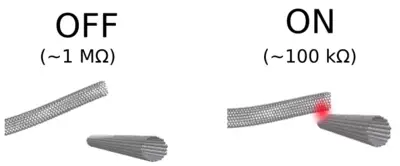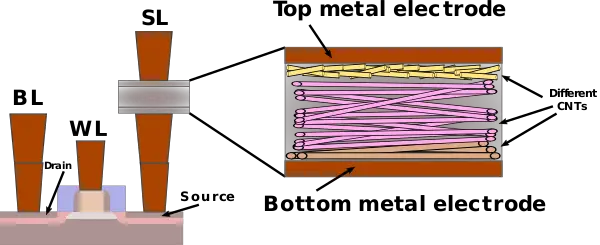(→Technology) |
|||
| Line 10: | Line 10: | ||
A typical NRAM cell consists of a non-woven fabric of hundred to thousand of carbon nanotubes (CNTs). NRAM relies on the basic principle of the [[wikipedia:van der Waals force|van der Waals force]] which is used to keep the CNTs attractive once they are connected and repulsive when they are apart. An electrostatic force is needed to overcome their repulsion and connect them. Once connect the tubes will remain connected until an electrostatic force of the opposite charge breaks them apart. Therefore the entire NRAM [[bit cell]] forms a stochastic array of resistive elements. An electrostatic force is used to combine a sufficiently large amount of CNTs to lower the resistance and an opposite force is used to break them apart to significantly increase the resistance. | A typical NRAM cell consists of a non-woven fabric of hundred to thousand of carbon nanotubes (CNTs). NRAM relies on the basic principle of the [[wikipedia:van der Waals force|van der Waals force]] which is used to keep the CNTs attractive once they are connected and repulsive when they are apart. An electrostatic force is needed to overcome their repulsion and connect them. Once connect the tubes will remain connected until an electrostatic force of the opposite charge breaks them apart. Therefore the entire NRAM [[bit cell]] forms a stochastic array of resistive elements. An electrostatic force is used to combine a sufficiently large amount of CNTs to lower the resistance and an opposite force is used to break them apart to significantly increase the resistance. | ||
| − | An NRAM cell is largely device-agnostic (both process-agnostic and transistor-agnostic) as well as substrate-agnostic. Once the FEOL devices are fabricated, metal contacts in the BEOL are exposed where desired. | + | An NRAM cell is largely device-agnostic (both process-agnostic and transistor-agnostic) as well as substrate-agnostic. Once the FEOL devices are fabricated, metal contacts in the BEOL are exposed where desired. A pure carbon nanotube slurry is then [[spin coated]] on top of those structures in order to form a uniform layer which is then followed by a bake and a top metal. |
| Line 17: | Line 17: | ||
It's worth noting that the CNTs forming the top and bottom parameter of the cell (in particular, the CNTs just below the top metal) do not move. Those have a protective barrier in order to permanently fix them to their location, preventing the top metal from slowly making its way into the cell. Most of the CNTs involved in creating the resistance are taken from the bottom. Those CNTs are pulled up in order to create a void and increase the resistance and are then forced back down in order to lower the resistance. Both the length and the diameter of the carbon nanotubes is carefully chosen depending on the attributes of the NRAM cell used. CNTs that are too long will simply short the cell. Likewise, CNTs that are too short can stand up and not switch either. Therefore it is important that the CNTs are in a specific range suitable for the specific NRAM. | It's worth noting that the CNTs forming the top and bottom parameter of the cell (in particular, the CNTs just below the top metal) do not move. Those have a protective barrier in order to permanently fix them to their location, preventing the top metal from slowly making its way into the cell. Most of the CNTs involved in creating the resistance are taken from the bottom. Those CNTs are pulled up in order to create a void and increase the resistance and are then forced back down in order to lower the resistance. Both the length and the diameter of the carbon nanotubes is carefully chosen depending on the attributes of the NRAM cell used. CNTs that are too long will simply short the cell. Likewise, CNTs that are too short can stand up and not switch either. Therefore it is important that the CNTs are in a specific range suitable for the specific NRAM. | ||
| − | |||
== Bibliography == | == Bibliography == | ||
Revision as of 21:08, 16 September 2018
NRAM (Nano-RAM) is a carbon nanotube-based resistance-change storage-class random access memory. NRAM is proprietary technology developed by Nantero licenseable to manufacturers.
Overview
NRAM uses carbon nanotubes (CTNs) as the switching medium situated between two electrodes located in the BEOL. The underlying device and substrate need not matter. It is resistance-change memory meaning an "off" state is a result of high resistance while an "on" state is a result of low resistance. The resistance of the bit cell is determined by the contact arrangement of the stochastic fabric of CNTs. When a sufficient amount of CNTs are touching each other, the overall resistance of the network of disordered CNTs is low, on the order of 100 kΩ. Likewise, when disconnected, the overall resistance of the network is very high, on the order of 1 MΩ. NRAM relies on the van der Waals force to keep CNTs bound to each other as well as apart.
Technology
A typical NRAM cell consists of a non-woven fabric of hundred to thousand of carbon nanotubes (CNTs). NRAM relies on the basic principle of the van der Waals force which is used to keep the CNTs attractive once they are connected and repulsive when they are apart. An electrostatic force is needed to overcome their repulsion and connect them. Once connect the tubes will remain connected until an electrostatic force of the opposite charge breaks them apart. Therefore the entire NRAM bit cell forms a stochastic array of resistive elements. An electrostatic force is used to combine a sufficiently large amount of CNTs to lower the resistance and an opposite force is used to break them apart to significantly increase the resistance.
An NRAM cell is largely device-agnostic (both process-agnostic and transistor-agnostic) as well as substrate-agnostic. Once the FEOL devices are fabricated, metal contacts in the BEOL are exposed where desired. A pure carbon nanotube slurry is then spin coated on top of those structures in order to form a uniform layer which is then followed by a bake and a top metal.
It's worth noting that the CNTs forming the top and bottom parameter of the cell (in particular, the CNTs just below the top metal) do not move. Those have a protective barrier in order to permanently fix them to their location, preventing the top metal from slowly making its way into the cell. Most of the CNTs involved in creating the resistance are taken from the bottom. Those CNTs are pulled up in order to create a void and increase the resistance and are then forced back down in order to lower the resistance. Both the length and the diameter of the carbon nanotubes is carefully chosen depending on the attributes of the NRAM cell used. CNTs that are too long will simply short the cell. Likewise, CNTs that are too short can stand up and not switch either. Therefore it is important that the CNTs are in a specific range suitable for the specific NRAM.
Bibliography
- Gervasi, Bill, Nantero Principal Systems Architect (September 14, 2018). Personal interview.
- IEEE Hot Chips 30 Symposium (HCS) 2018

